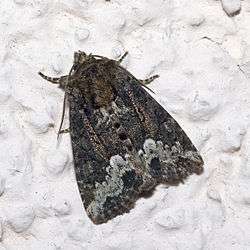Marbled minor
| Marbled minor | |
|---|---|
 | |
| Scientific classification | |
| Kingdom: | Animalia |
| Phylum: | Arthropoda |
| Class: | Insecta |
| Order: | Lepidoptera |
| Family: | Noctuidae |
| Genus: | Oligia |
| Species: | O. strigilis |
| Binomial name | |
| Oligia strigilis (Linnaeus, 1758) | |
The marbled minor (Oligia strigilis) is a moth of the family Noctuidae. It is distributed throughout Europe. then East through the Palearctic to Central Asia, and the Altai Mountains. It rises to heights of over 1500 meters in the Alps.
This is a rather small species (wingspan 24–29 mm), the forewings usually being dark brown with a pale subterminal band, the hindwings pale brown. Melanic forms are often encountered, especially in industrial areas.
Technical description and variation
Wingspan 24–29 mm. Forewing brownish grey, reddish grey, reddish brown, or blackish; the space between outer and submarginal lines often white or grey, or luteous, or rufous or concolorous with ground colour; the 3 stigmata ringed with black, either paler than the ground or lost in the dark suffusion; inner and outer lines blackish, conversely edged with paler and dentatelunulate, the pale edging of outer line generally more conspicuous, whitish, below the middle; terminal area dark, forming two blotches one on each fold; a dark costal blotch before submarginal line; a slight black dash from base below cell, and another above inner margin near base; hindwing dark or light fuscous; the type form has the outer band whitish and the ground colour reddish grey or reddish brown.[1]
This species is almost identical to its relatives the rufous minor (O. versicolor) and the tawny marbled minor (O. latruncula) and identification generally requires dissection to study the genitalia. See Townsend et al.[2] for genitalia images and an identification key.This species averages slightly larger than its two cousins but the dimensions of all three species overlap. It flies at night from May to July and is attracted to light and sugar.
The larva is purplish-brown with yellow stripes and feeds internally in various grasses including Agropyron, Dactylis, Elytrigia and Poa.[3] This species overwinters as a larva.
Habitats include, for example, forests, meadows, moors, rocky areas, park-like landscapes, steppe and settlements.
- ^ The flight season refers to the British Isles. This may vary in other parts of the range.
References
- ↑ Seitz, A. Ed., 1914 Die Großschmetterlinge der Erde, Verlag Alfred Kernen, Stuttgart Band 3: Abt. 1, Die Großschmetterlinge des palaearktischen Faunengebietes, Die palaearktischen eulenartigen Nachtfalter, 1914
- ↑ Martin C. Townsend, Jon Clifton and Brian Goodey, 2010 British and Irish moths: an illustrated guide to selected difficult species (covering the use of genitalia characters and other features) Butterfly Conservation pdf
- ↑ "Robinson, G. S., P. R. Ackery, I. J. Kitching, G. W. Beccaloni & L. M. Hernández, 2010. HOSTS - A Database of the World's Lepidopteran Hostplants. Natural History Museum, London.".
- Chinery, Michael Collins Guide to the Insects of Britain and Western Europe 1986 (Reprinted 1991)
- Skinner, Bernard Colour Identification Guide to Moths of the British Isles 1984
External links
- Lepiforum Includes photographs of genitalia
- Funet Taxonomy
- Fauna Europaea